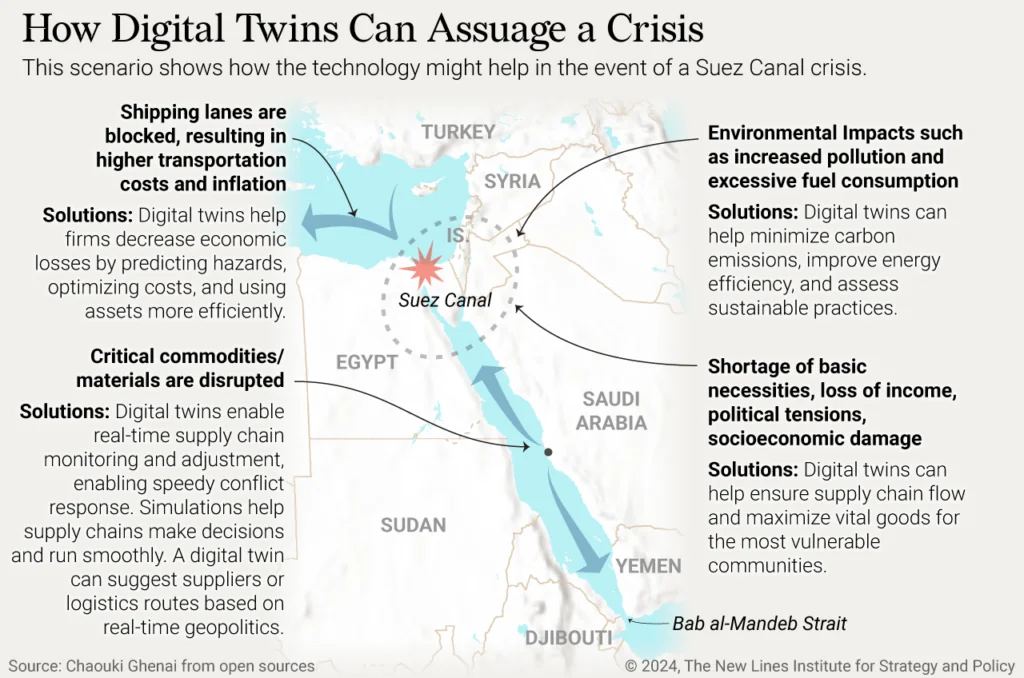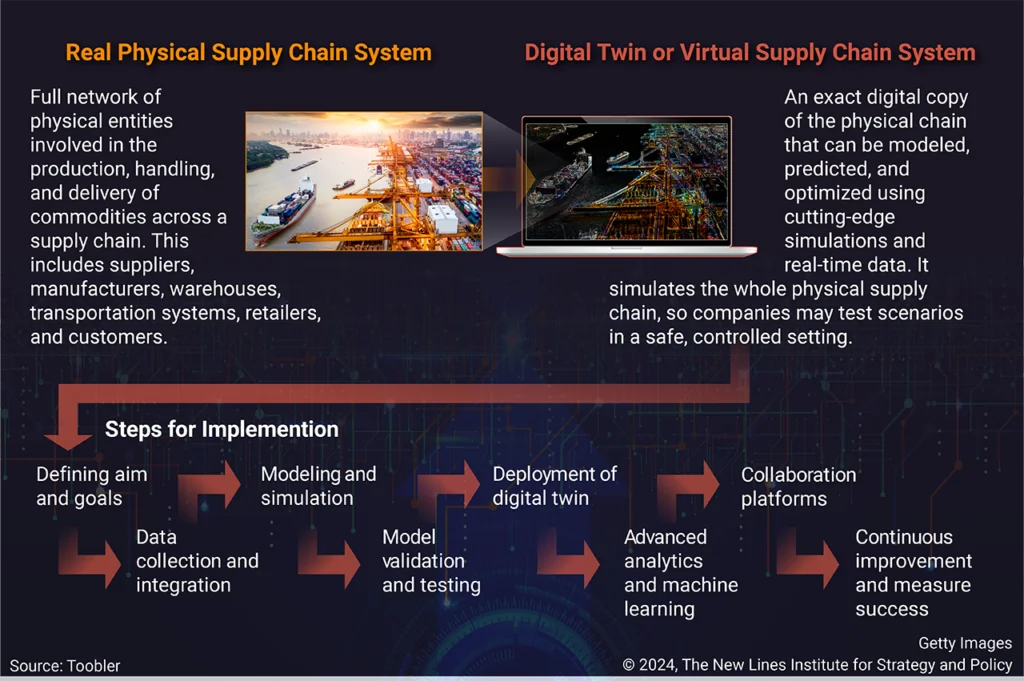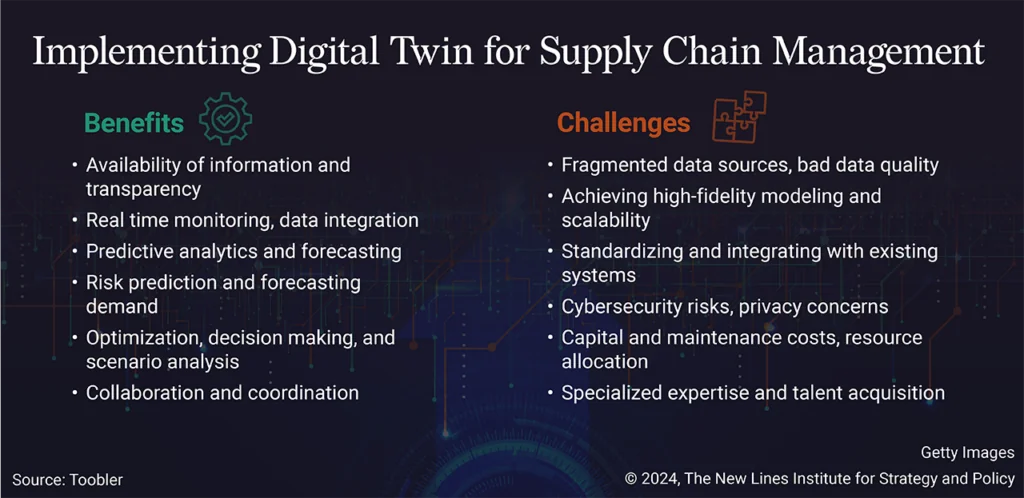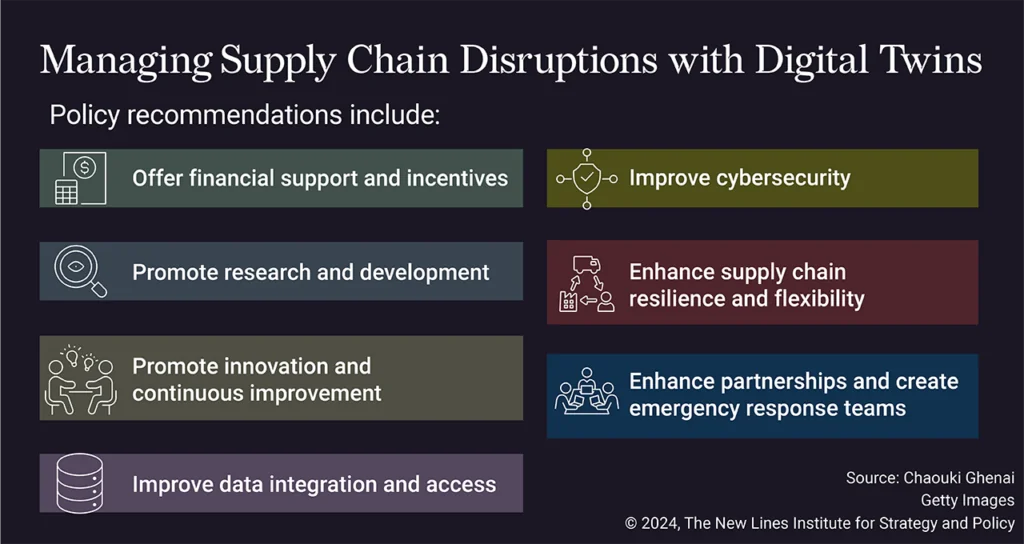Traditional supply chains, and the shipping supply chain in particular, are susceptible to significant impacts from a variety of global events, such as pandemics, natural disasters, wars, and trade disputes. Conflict-related instability and infrastructure damage can cause significant and costly disruptions in transportation, leading to damaged goods, longer shipping times, spiking shipping costs, shortages, and congestion at ports. Combining modern data analytics, real-time monitoring, and predictive modelling is required to estimate the likelihood of interruptions in supply chains. Companies can improve visibility into supply chains and anticipate potential hazards by utilizing emerging technologies such as artificial intelligence, the internet of things (IoT), blockchain, and others. However, these endeavors can be difficult to accomplish due to the intricate nature of global supply chains. Consequently, in addition to making predictions, organizations need to prioritize the development of resilience and flexibility to react rapidly to disturbances.
One way for businesses to improve their capacity to predict, respond to, and recover from interruptions is by using a digital twin, a virtual model that replicates their supply chains’ procedures, assets, and flows of goods and information. The ability to simulate, analyze, and optimize activities in real time is an essential component of contemporary supply chain resilience methods. Through greater visibility, predictive analytics, and optimization capabilities, digital twin technology presents a tremendous opportunity to reduce the impact of supply chain constraints. This could prove useful during conflicts such as the ongoing Red Sea shipping crisis and rising tensions in East Asia.
To mitigate risks proactively, companies could use digital twin technology to model potential interruptions, such as transportation problems or delays from suppliers. A strategy including data integration, sophisticated analytics, and collaborative platforms is necessary to maximize the benefits of this technology and meet the complex difficulties associated with supply chain management.

Implementation Strategies
A supply chain digital twin uses real-time data to forecast the dynamics of a supply chain, allowing it to be analyzed and anomalous circumstances to be predicted and planned for. Digital twins provide monitoring, simulation, and optimization of physical items, processes, and systems. The technology is being adopted across sectors to increase efficiency and save costs. For example, General Electric said it is using the technology to model its wind farms, allowing it to design more efficient turbines and optimize usage as conditions change.
Before deploying a digital twin system, it is necessary to have a comprehensive grasp of the architecture contained within. In the context of supply chain management, the implementation strategies for digital twin integration include:
- Define goals: Set the main objectives of the digital twin supply chain project (e.g., reduce shipping time and cost, increase revenue, reduce downtime, etc.). Analyze the degree to which the company is prepared to implement digital twin technology, including assessing infrastructure, IT systems, data management policies, and staff. Primary participants, hardware, and software should be identified.
- Collect and integrate data: Collecting real-time data on inventory levels, production processes, and transportation conditions involves the implementation of Internet of Things (IoT) sensors and radio-frequency identification (RFID).
- Modeling and simulation: Construct digital or computer models of the supply chain, which should include suppliers, production facilities, warehouses, and transportation networks. Conduct simulations to assess various scenarios and understand their influence on the supply chain. These scenarios may include shifting demand, disruptions, and transportation delays.
- Model validation and testing: Validate and assess the digital twin system before deploying it. This ensures it appropriately replicates its physical counterpart and provides vital insights.
- Deployment: After testing and validation, the digital twin can be deployed. Incorporating it into the operational procedures and systems is essential for successful deployment. Create a monitoring system that highlights key performance indicators and potential problems.
- Advanced analytics and machine learning: Analyze past data to predict future trends, potential disruptions, and demand fluctuations using advanced analytics and machine-learning algorithms. Implement optimization algorithms to enhance inventory management, production scheduling, and logistical operations.
- Collaboration platforms: Use integrated communication tools to facilitate collaboration and information exchange among stakeholders in the supply chain.
- Continuous improvement: Collaborating with digital twins requires updating and improving the virtual model using the information obtained and the modifications made to the physical entity or the operational goals. Establish key performance indicators to evaluate the level of success achieved by adopting the digital twin.

Implementation Strategies for Digital Twin in Supply Chain Management
Key Benefits
Among the most important advantages of using a digital twin for supply chain management are:
- Improved availability of information and transparency: Digital twins enable organizations to monitor inventory levels, manufacturing rates, and shipment statuses in real time, which can help firms quickly and accurately analyze data and adapt to shifting business requirements. To generate a full perspective of the supply chain, it is necessary to integrate data from a variety of sources, such as IoT devices, enterprise resource planning systems, and logistics platforms.
- Predictive analytics and forecasting: Identifying potential risks and disruptions such as delays caused by suppliers, transportation problems, and geopolitical events and determining the impact they will have on the supply chain are important parts of risk prediction. Demand forecasting, which uses historical data and sophisticated algorithms to predict future demand, helps anticipate prospective shortages and adjust procurement strategies.
- Optimization and decisions making: Scenario analysis is the process of simulating multiple scenarios to gain an understanding of the influence that circumstances such as demand spikes and supplier failures could have on the supply chain and using that data to establish contingency plans. Digital twins can enable ongoing improvement, provide precise real-time data, and create realistic, customizable simulations to improve cost efficiency, risk management, and decision-making.
- Collaboration and coordination: The coordination and alignment of production schedules, procurement plans, and logistical operations is necessary to ensure a continuous flow of goods and materials. Digital twins can enhance collaboration among stakeholders by facilitating the exchange of real-time data and insights.
Challenges and Mitigation Strategies
Successful implementation of a digital twin requires taking initiative to confront potential problems. For example, data from supply chains is spread across systems and departments, making integration problematic. A considerable number of businesses continue to use obsolete legacy systems incompatible with modern digital twin platforms and could yield inaccurate modeling. Implementing systems that can collect and process real-time data from a variety of sensors and devices can be difficult and expensive. Mitigation techniques include conducting thorough compatibility research, using middleware solutions, and planning for phased integration with extensive testing. In addition, data must be thoroughly validated and sensors must be precisely calibrated.
To develop high-fidelity digital twins that precisely reproduce physical systems requires sophisticated modeling approaches and a substantial amount of computer infrastructure. Scaling digital twin models to manage greater complexity and data volume can be a challenge as supply chains continue to expand. Modular design, edge computing, cloud scalability, advanced analytics, and robust data management are needed to scale digital twin models to handle more complexity and data. These mitigating methods, allow companies to keep their digital twin systems efficient and responsive.
Implementing digital twin technology requires significant initial investments in hardware, software, and training. In addition, keeping digital twins accurate and functional requires regular maintenance and upgrading, a potentially costly, resource-intensive endeavor. Measures to mitigate the financial impact include weighing costs and benefits, securing financing or subsidies, and implementing technology in stages.
Cyberattacks are a potential risk for digital twins since they rely on intensive data collecting and communication in real time. When collecting and processing personal data inside the supply chain, it is important to comply with data privacy standards, such as the General Data Protection Regulation. Digital twins are networked systems that can be hacked, causing data breaches, operational interruptions, and sabotage. State-of-the-art cybersecurity measures, such as encrypted data transmissions, restricted access, frequent security assessments, and methods for addressing incidents, are all included in the mitigation plans.
A lack of technical expertise and training can limit digital twin technology implementation and operation. This can be mitigated by extensive training, judicious hiring, and ongoing professional development.
The use of digital twin technology requires following sets of complex local, national, and international regulations that can change over time. Managing large quantities of sensitive information raises concerns around data privacy. Mitigation strategies include staying current on regulations, collaborating with regulators, and audit compliance as well as implementing stringent data privacy regulations, following data protection laws, and anonymizing data when possible.

Using Digital Twins During Conflicts
There may be a scarcity of essential goods and services if conflicts interrupt supply chains. By creating a digital copy of the supply chain, digital twin technology can help deal with these interruptions by facilitating scenario planning, real-time monitoring, and predictive analytics. Two scenarios illustrate the potential use of digital twin technology:
Red Sea Shipping Crisis: In October 2023, militants from Yemenis’ al-Houthi rebel group began attacking cargo vessels in the Red Sea. The deadly attacks have interrupted supply chains, raised shipping prices, and clogged ports, creating implications for businesses worldwide. Before the attacks began, the Red Sea saw 30% of the world’s commercial shipping, a number that was cut in half by March 2024.
Digital twin systems could help shipping companies gain real-time information about the supply chain, anticipate disruptions, and make informed decisions regarding rerouting tactics. Such systems could help to improve efficiency and reactivity to interruptions, including the utilization of modern tracking systems, data analytics, and automation.
China-Taiwan Conflict: Escalating tensions between China and Taiwan could threaten technology businesses worldwide if they boil over into active conflict. Taiwan produces more than 60% of the world’s semiconductors, which are used in a variety of devices from automobiles to mobile phones. Taiwan also is a significant source of computer hardware and components, among other industrial exports. China, meanwhile, serves as the final assembly base for a significant amount of the electronic appliances and information technology items that are manufactured. China can export finished goods all over the world by utilizing its vast production capacity and huge logistical infrastructure.
Because of this mutually beneficial production connection, the supply chains that span the Taiwan Strait are intricately connected. Taiwanese producers of parts and Chinese manufacturers of product assemblers exchange billions of dollars’ worth of intermediate components and commodities on an annual basis. A military confrontation that disrupts cross-strait trade and manufacturing could have worldwide ramifications, causing shortages and price surges that would affect a variety of different businesses. If tensions continue to escalate, it may be possible to use digital twin technology to reduce risks by proactively modelling scenarios and planning for contingencies.
Policy Recommendations
By enabling digital twin deployment and use, governments and organizations can promote long-term supply-chain resilience, innovation, and sustainability by improving efficiency, reducing costs and risk, and optimizing processes across the lifecycle of assets and activities.
Policies to promote resilience, innovation, and robust digital twin adoption should come in the form of:
- Financial Incentives: Encourage the use of digital twin technology through grants and tax incentives that support companies engaging in digital twin technology by reducing initial expenses and increasing adoption. Offer tax credits or deductions for digital twin infrastructure, software, and training expenditures.
- Research and Development: Fund digital twin R&D to encourage collaboration among the government, research institutions, and industrial sectors to advance innovation and practice.
- Continuous Monitoring and Evaluation: Track digital twin and supply chain resilience projects with key performance indicators. Assess supply chain policies and digital twin systems to identify improvements. Enhance innovative ecosystems by creating hubs and centers of excellence for supply chain resilience and digital twin technology.
- Improved Data Integration and Access: Create and enforce industry-wide data standards to integrate and interoperate digital twin systems. Data security and privacy should be protected by supply chain data sharing and transparency legislation. Creating centralized data repositories allows supply chain stakeholders to access important data in real time. Secure data exchange protocols enable collaboration and information sharing while protecting sensitive data.
- Improved Cybersecurity: Use strict cybersecurity requirements for digital twin systems to prevent cyberattacks and data breaches. Perform frequent security audits and vulnerability assessments to detect and mitigate problems. Develop awareness and training programs. Train employees and stakeholders on cybersecurity and data protection best practices. Awareness campaigns should emphasize cybersecurity in digital twin adoption and supply chain management.
- Enhanced Supply Chain Resilience and Flexibility: Encourage firms to diversify their suppliers to reduce dependence and ensure resilience to interruptions. Support the creation of alternate transportation routes and logistical methods to ensure continuity in the event of disruptions. Prepare for disruptions and require digital twin technologies for scenario planning and simulation. Companies must create and maintain supply chain interruption contingency plans.
- Collaboration: Connect suppliers, manufacturers, logistics providers, and government agencies. Discuss difficulties, share best practices, and coordinate supply chain disruption responses. Create government-industry task forces to examine supply chain vulnerabilities and propose strategic solutions. Create emergency response teams to give timely help and resources during supply chain disruptions.

Prof. Chaouki Ghenai is a Non-Resident Senior Fellow for Energy Strategy and Policy at the New Lines Institute. He oversees new energy initiatives for New Lines Institute, including: Future and Innovative Energy Technologies, Geopolitics of Energy Transformation, Clean Energy Financing, New Energy Policies, and Sustainable Energy and Society. He has more than 25 years of research experience in the energy field and management of Clean Energy Research Programs and Research Funding.
The views expressed in this article are those of the author and not an official policy or position of the New Lines Institute.






